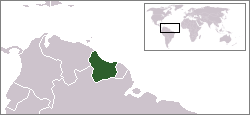Dutch Guiana
Dutch Guiana ( Dutch Nederlands-Guyana or Nederlands-Guiana ) was the collective name for Dutch colonies on the coast of Guiana.
history
As early as 1600 the Dutch had established smaller trading posts on the rivers between the Pomeroon in the west and Suriname in the east. After the establishment of the West India Company (WIC) in 1621, the colonies of Pomeroon, Essequibo (including Demerara ) and Berbice belonged to the WIC's trade monopoly. After Suriname formally fell to the Netherlands with the Peace of Westminster in 1674 , this entire area was also known as Dutch Guiana.
The area included what is now Suriname and Guyana .
During the coalition wars and the British-French colonial conflict, the British occupied Dutch Guiana from 1799 to 1802 and from 1804 to 1815. By the British-Dutch Treaty of 1814 , Dutch Guiana was divided. Suriname became a Dutch colony again; Pomeroon, Essequibo and Berbice, which later became British Guiana , finally came to the United Kingdom.
Suriname, along with the Cape Colony and Ceylon, was one of three "lost" Dutch colonies. In exchange for the lost territories, the United Kingdom of the Netherlands was formed from the former Batavian Republic , the Austrian Netherlands and the Principality of Liège .
See also
literature
- Cornelis Ch. Goslinga: The Dutch in the Caribbean and in the Guianas 1680-1791 . van Gorcum, Assen 1985.
- Frank van de Kreeke: Essequebo en Demerary, 1741–1781: beginfase van de Britse overname . Leiden University, Leiden 2013.
- Johan C. van Langen: De Britse overname van de Nederlandse koloniën Demerary, Essequebo en Berbice. Van economische overvleugeling naar politieke overheersing 1740–1815 . Universiteit van Amsterdam, Amsterdam 2003.
- Pieter Marinus Netscher: Geschiedenis van de koloniën Essequebo, Demerary en Berbice, van de vestiging der Nederlanders aldaar tot op onzen tijd . Nijhoff, 's-Gravenhage 1888.
Web links
- Literature by and about Dutch Guiana in the WorldCat bibliographic database

